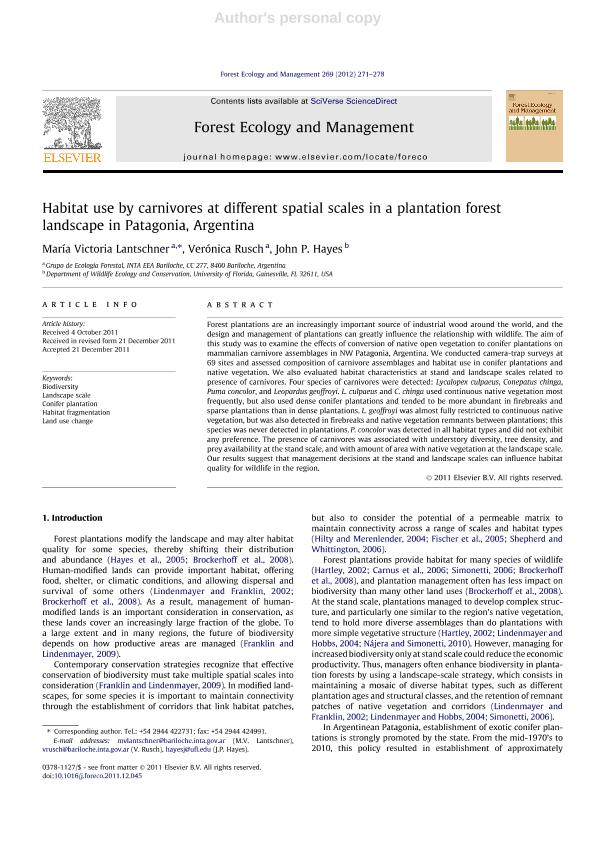Mostrar el registro sencillo del ítem
dc.contributor.author
Lantschner, María Victoria

dc.contributor.author
Rusch, Verónica
dc.contributor.author
Hayes, John P.
dc.date.available
2023-05-15T14:56:42Z
dc.date.issued
2012-04
dc.identifier.citation
Lantschner, María Victoria; Rusch, Verónica; Hayes, John P.; Habitat use by carnivores at different spatial scales in a plantation forest landscape in Patagonia, Argentina; Elsevier Science; Forest Ecology and Management; 269; 4-2012; 271-278
dc.identifier.issn
0378-1127
dc.identifier.uri
http://hdl.handle.net/11336/197513
dc.description.abstract
Forest plantations are an increasingly important source of industrial wood around the world, and the design and management of plantations can greatly influence the relationship with wildlife. The aim of this study was to examine the effects of conversion of native open vegetation to conifer plantations on mammalian carnivore assemblages in NW Patagonia, Argentina. We conducted camera-trap surveys at 69 sites and assessed composition of carnivore assemblages and habitat use in conifer plantations and native vegetation. We also evaluated habitat characteristics at stand and landscape scales related to presence of carnivores. Four species of carnivores were detected: Lycalopex culpaeus, Conepatus chinga, Puma concolor, and Leopardus geoffroyi. L. culpaeus and C. chinga used continuous native vegetation most frequently, but also used dense conifer plantations and tended to be more abundant in firebreaks and sparse plantations than in dense plantations. L. geoffroyi was almost fully restricted to continuous native vegetation, but was also detected in firebreaks and native vegetation remnants between plantations; this species was never detected in plantations. P. concolor was detected in all habitat types and did not exhibit any preference. The presence of carnivores was associated with understory diversity, tree density, and prey availability at the stand scale, and with amount of area with native vegetation at the landscape scale. Our results suggest that management decisions at the stand and landscape scales can influence habitat quality for wildlife in the region.
dc.format
application/pdf
dc.language.iso
eng
dc.publisher
Elsevier Science

dc.rights
info:eu-repo/semantics/openAccess
dc.rights.uri
https://creativecommons.org/licenses/by-nc-nd/2.5/ar/
dc.subject
BIODIVERSITY
dc.subject
CONIFER PLANTATION
dc.subject
HABITAT FRAGMENTATION
dc.subject
LAND USE CHANGE
dc.subject
LANDSCAPE SCALE
dc.subject.classification
Ecología

dc.subject.classification
Ciencias Biológicas

dc.subject.classification
CIENCIAS NATURALES Y EXACTAS

dc.title
Habitat use by carnivores at different spatial scales in a plantation forest landscape in Patagonia, Argentina
dc.type
info:eu-repo/semantics/article
dc.type
info:ar-repo/semantics/artículo
dc.type
info:eu-repo/semantics/publishedVersion
dc.date.updated
2023-04-19T15:02:24Z
dc.journal.volume
269
dc.journal.pagination
271-278
dc.journal.pais
Países Bajos

dc.journal.ciudad
Amsterdam
dc.description.fil
Fil: Lantschner, María Victoria. Consejo Nacional de Investigaciones Científicas y Técnicas. Centro Científico Tecnológico Conicet - Patagonia Norte; Argentina. Instituto Nacional de Tecnología Agropecuaria. Centro Regional Patagonia Norte. Estación Experimental Agropecuaria San Carlos de Bariloche. Grupo de Ecología Forestal; Argentina
dc.description.fil
Fil: Rusch, Verónica. Instituto Nacional de Tecnología Agropecuaria. Centro Regional Patagonia Norte. Estación Experimental Agropecuaria San Carlos de Bariloche. Grupo de Ecología Forestal; Argentina
dc.description.fil
Fil: Hayes, John P.. University of Florida. Department of Wildlife Ecology and Conservation; Estados Unidos
dc.journal.title
Forest Ecology and Management

dc.relation.alternativeid
info:eu-repo/semantics/altIdentifier/url/https://www.sciencedirect.com/science/article/pii/S0378112711007924
dc.relation.alternativeid
info:eu-repo/semantics/altIdentifier/doi/https://doi.org/10.1016/j.foreco.2011.12.045
Archivos asociados
